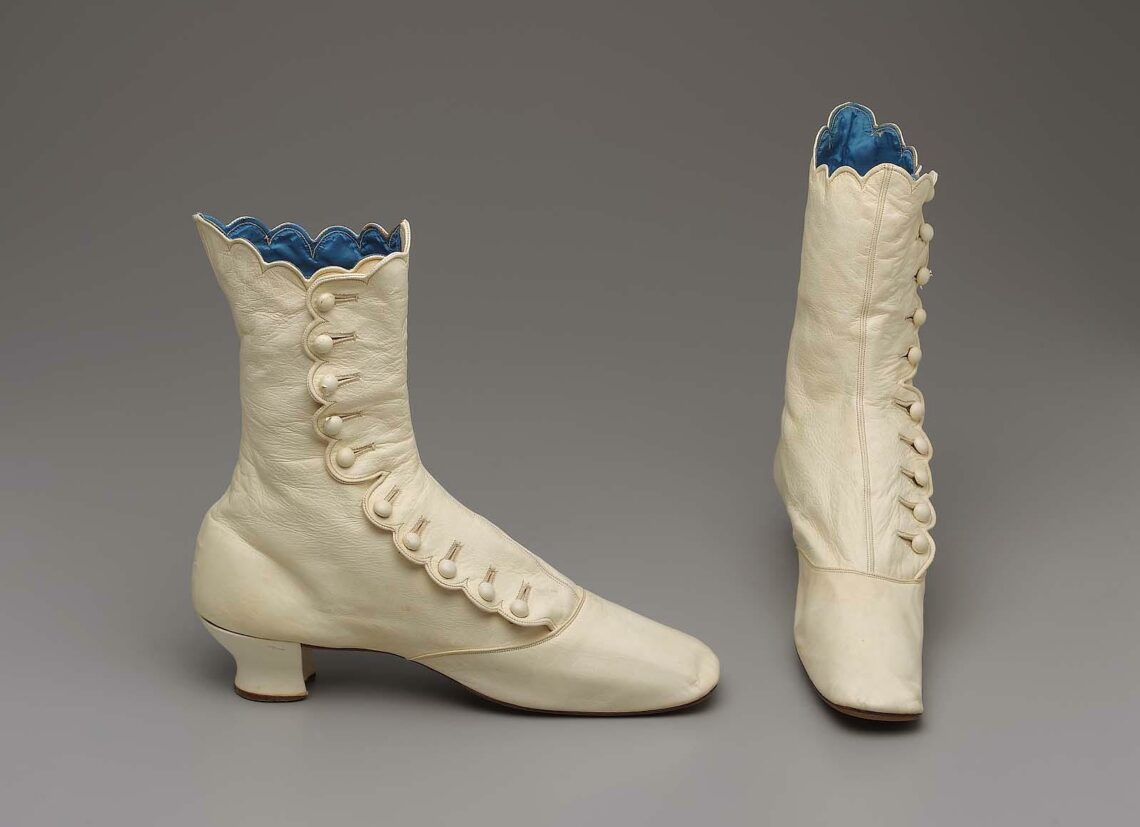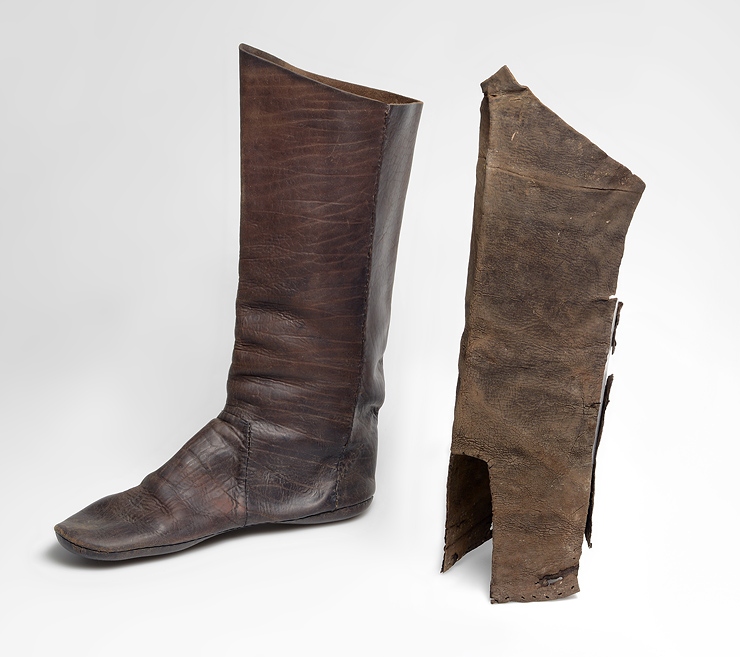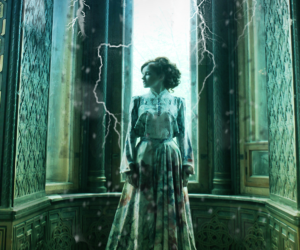
These Boots Are Made for Walking: Boots Throughout History
1 – These boots are made for talkin’. Well, #threadtalk, anyway.👢
Yup, this edition is all about the sexy, sturdy, subversive, and sumptuous footwear we know and love. Docs, Fluevogs, cowboy, military: they all share history.
Below: 1895-1900, Museum at Fit; Austria or England

2 – Like hats, tunics & other foundational human garments, it’s hard to say when shoes became boots. Likely they morphed from hose & leather shoes to this recognizable hybrid.
The archaeological record goes way back. Here, an Assyrian soldier rocks some sweet boots in 7thC BCE.

3 – To the surprise of zero people who know about cowboy boots, we see boots in societies with big hunting and horse energy.🐎🐎🐎
This gorgeous statuette of Artemis has some lovely detailed boots, ideal for trying to keep the hell away from everyone else in the woods. 3-1C BCE.

4 – Roman foot soldiers wore a sandal-boot hybrid called a caligae. They were openwork, so kind of like 80s jelly shoes, but the bottoms were hobnailed.
They were issued to soldiers and came in a variety of designs–some surprisingly modern looking. These came from Trimontium.

5 – Boots also grew into a sign of class. Protecting your feet, after all, meant you could afford the materials to do so. These Egyptian examples from the 6-7th century have gorgeous patterns on them still visible & would have indicated status & prestige. Better than a pedicure.

6 – By and large, leather was used primarily for the construction of shoes in the pre-industrial world. Research has not determined much of a difference between gendered footwear, save footbed size.
This recreation from Tønsberg, Norway based on 12th C remnants just blew my mind

7 – Of course, boots are also deeply rooted in the military. We see them in armor from all around the world but also influencing fashion once we get in to the Imperial age & Englishmen start emulating soldiers even if they aren’t. The Hessian boot became a staple of Regency wear.

8 – These stunning moccasins date from the same period as the Hessian boots above, and are made by the Huron. The intricate embroidery and bold colors are still vibrant today, even though they’re over two hundred years old. Absolutely remarkable.

9 – On the opposite side, we have the most durable boots I have ever seen. These date from 1750-1774, and include removable spurs made of iron. I don’t know about you, but I’m not sure I could walk straight in these, let alone get on a horse. But then again, I trip in sneakers.

10 – The age of colonialism does bring us a whole lot of gendered clothing, and women’s wear becomes fairly clear. The line between “shoe” and “boot” is often blurred.
However, you all know my weakness for moiré and green, so these gorgeous ankle boots from 1830-40 were a must.

11 – Boots, of course, find their way into art, as well. One of my all time favorite painters, Artemisia Gentileschi, depicted Esther here before her husband, King Ahasuerus. I have no doubt that she chose to put him in white boots for a reason. Pristine, privileged. 17th C

12 – Or, the absence of one’s boots makes for quite a shocking show. This is a portrait of Don Quixote by Célestin Nanteuil. His red legs almost look like hose, but you realize he’s not wearing anything and his armor is strewn about. Madness. 1873.

13 – Another piece we can’t forget, before we look at more boots, is the spurs. Though brutal in practice, their design is rather stunning and ornate. This example is like from Spain and is called a Rowel Spur, dating from the mid-17th C. A sign of wealth, to be sure.

14 – And we cannot, of course, forget the dandy macaronis. Their boots, though often mimicking the feel of military style, were most certainly for show. These caricatures were quite popular; this one is of William John Kerr, Earl of Acrum, afterward Marquess of Lothian, ca 1771.

15 – These Russian boots date to 1867 and were bought for £1 13 shillings and 6 pence at the Paris Universal exhibition (according to the V&A, and they’d know, right?). The leatherwork and stitching is quite gorgeous, and that tassel brings it right over the top, IMHO.

16 – Nights in black satin? These boots are scalloped and made of curves to die for. Likely part of a mourning ensemble, they date from 1865-1870, and if I could fit even part of my foot in them I would wear them right now. 🖤🖤🖤

17 – These are another 1860s set, in a color I would commit a felony for. The Met gives us almost no information on these other than that they are “probably American” but I just adore the two tone leather and velvet here. And that little knob of a heel!

18 – The 1890s are not messing around. Who would think that adding a heel and going with just a regular calfskin brown would be so damned sexy?
I need a moment. The yellow lining is really the thing that’s killing me. Made in Austria, for London audience, purchased in 1923.

19 – These marvelous embroidered boots feature side-lacing, which for the time period was considered a bit of a throwback.
Whatever it is, it works. I mean, even the HEEL on this thing is embroidered. Can you imagine working that metallic thread into the silk? Whew. 🔥

20 – And lastly (I could go on all night) these are heart-stopping boots from the Museum at FIT–and they’re for a bicycle ensemble! The date is 1898, and I just love the swirls and playfulness of design. Corduroy is aways sporty chic, and it’s got a definite proto-sneaker vibe.

21 – Some fun sources this week, and some cool extras: https://en.wikipedia.org/wiki/Boot
https://www.fitnyc.edu/museum/exhibitions/_hide/boots.php
https://www.jstor.org/stable/4516471?read-now=1&refreqid=excelsior%3A0ea06fdac84d31b0a46275c25f9a31a7#page_scan_tab_contents
https://www.metmuseum.org/toah/hd/aams/hd_aams.htm
https://en.wikipedia.org/wiki/Caligae
https://www.museumoflondon.org.uk/discover/these-boots-were-made-romans
https://www.trimontium.co.uk/archive-item/caligae-replica/
https://www.vam.ac.uk/shoestimeline/
22 – Remember, Patrons get *extra* #threadtalk content! I’ve also got a tip jar (link in bio) & super follows, now. (People asked, so I provide! 🌈)
Thanks for hanging out with me today & learning all about glorious boots! I miss my old combat boots… I painted them myself.
23 – I cannot believe the typo in the first post, but whatever. Books are on brand. But that was 100% autocorrect.
Originally tweeted by Natania Barron (@NataniaBarron) on July 28, 2022.





